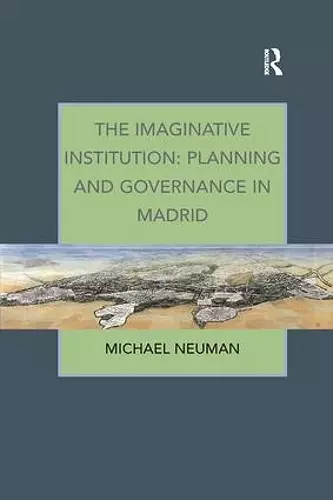The Imaginative Institution: Planning and Governance in Madrid
Format:Paperback
Publisher:Taylor & Francis Ltd
Published:23rd Nov '16
Currently unavailable, and unfortunately no date known when it will be back
This paperback is available in another edition too:
- Hardback£160.00(9781409405412)

Every 20 years since 1920, Madrid has undergone an urban planning cycle in which a city plan was prepared, adopted by law, and implemented by a new institution. This preparation-adoption-institutionalization sequence, along with the institution's structures and procedures, have persisted - with some exceptions - despite frequent upheavals in society. The planning institution itself played a lead role in maintaining continuity, traumatic history notwithstanding. Why and how was this the case? Madrid's planners, who had mostly trained as architects, invented new images for the city and metro region: images of urban space that were social constructs, the products of planning processes. These images were tools that coordinated planning and urban policy. In a complex, fragmented institutional milieu in which scores of organized interests competed in overlapping policy arenas, images were a cohesive force around which plans, policies, and investments were shaped. Planners in Madrid also used their images to build new institutions. Images began as city or metropolitan designs or as a metaphor capturing a new vision. New political regimes injected their principles and beliefs into the governing institution via images and metaphors. These images went a long way in constituting the new institution, and in helping realize each regime's goals. This empirically-based life cycle theory of institutional evolution suggests that the constitutional image sustaining the institution undergoes a change or is replaced by a new image, leading to a new or reformed institution. A life cycle typology of institutional transformation is formulated with four variables: type of change, stimulus for change, type of constitutional image, and outcome of the transformation. By linking the life cycle hypothesis with cognitive theories of image formation, and then situating their synthesis within a frame of cognition as a means of structuring the institution, this book arrives at a new theory
'Firstly, congratulations. It's truly a magnificent book and, I believe, extremely important from the Madrid perspective where there is a dearth of analysis and critical perspective.' Javier Ruiz, Universidad Politecnica de Madrid, Spain 'Michael Neuman has tackled and unravelled the fundamental elements that underpin successful urban governance and public administration. He has delivered a conceptual framework to guide anyone interested in designing, delivering and managing urban environments. With the pressing need to transform cities to be environmentally sustainable, I can think of no better guide for planners, urban designers, landscape architects, architects, urban managers and politicians at every level of government than this book.' Alec Tzannes, UNSW Sydney, Australia '... The Imaginative Institution is a well-written book that both urban scholars and planners, along with scholars in numerous other disciplines, will welcome. ... Neuman succeeds in the integration of multidisciplinary perspectives to inform his work on the historic and contempormy development of regional planning in Madrid.' Journal of Planning Education and Research
ISBN: 9781138260764
Dimensions: unknown
Weight: 453g
256 pages